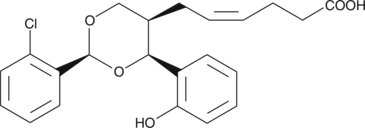Chemicals
Showing 22351–22500 of 41137 results
-
Ghrelin is an endogenous ligand for the growth hormone (GH) secretagogue receptor (GHSR).{7811} Ibutamoren is an orally-active, non-peptidic agonist of GHSR (Kd = 0.4 nM) and, as a result, is a GH secretagogue.{3021,3308} It elevates GH in dogs after oral doses as low as 0.125 mg/kg, without significantly changing plasma levels of aldosterone, luteinizing hormone, thyroxine, or prolactin.{30759}
Brand:CaymanSKU:-Available on backorder
The phosphatidylinositol 3-kinase (PI3K) signaling pathway has central roles in cell growth, development, and survival.{13740,17822} IC-87114 is a cell-permeable selective inhibitor of the PI3K catalytic subunit p110δ (IC50 = 0.5 μM).{24748} It less effectively inhibits p110γ and p110β (IC50 = 29 and 75 μM, respectively) and has no significant effect on p110α and several other kinases.{24748,24749} This product is used to elucidate the role of p110δ in cells, including neutrophils, natural killer cells, and other types of leukocytes.{24748,24749,24750,21846,24751} It has also been used in mice.{24752}
Brand:CaymanSKU:11589 - 1 mgAvailable on backorder
The phosphatidylinositol 3-kinase (PI3K) signaling pathway has central roles in cell growth, development, and survival.{13740,17822} IC-87114 is a cell-permeable selective inhibitor of the PI3K catalytic subunit p110δ (IC50 = 0.5 μM).{24748} It less effectively inhibits p110γ and p110β (IC50 = 29 and 75 μM, respectively) and has no significant effect on p110α and several other kinases.{24748,24749} This product is used to elucidate the role of p110δ in cells, including neutrophils, natural killer cells, and other types of leukocytes.{24748,24749,24750,21846,24751} It has also been used in mice.{24752}
Brand:CaymanSKU:11589 - 10 mgAvailable on backorder
The phosphatidylinositol 3-kinase (PI3K) signaling pathway has central roles in cell growth, development, and survival.{13740,17822} IC-87114 is a cell-permeable selective inhibitor of the PI3K catalytic subunit p110δ (IC50 = 0.5 μM).{24748} It less effectively inhibits p110γ and p110β (IC50 = 29 and 75 μM, respectively) and has no significant effect on p110α and several other kinases.{24748,24749} This product is used to elucidate the role of p110δ in cells, including neutrophils, natural killer cells, and other types of leukocytes.{24748,24749,24750,21846,24751} It has also been used in mice.{24752}
Brand:CaymanSKU:11589 - 5 mgAvailable on backorder
The phosphatidylinositol 3-kinase (PI3K) signaling pathway has central roles in cell growth, development, and survival.{13740,17822} IC-87114 is a cell-permeable selective inhibitor of the PI3K catalytic subunit p110δ (IC50 = 0.5 μM).{24748} It less effectively inhibits p110γ and p110β (IC50 = 29 and 75 μM, respectively) and has no significant effect on p110α and several other kinases.{24748,24749} This product is used to elucidate the role of p110δ in cells, including neutrophils, natural killer cells, and other types of leukocytes.{24748,24749,24750,21846,24751} It has also been used in mice.{24752}
Brand:CaymanSKU:11589 - 50 mgAvailable on backorder
IC261 is a reversible, ATP-competitive inhibitor of casein kinase 1 (CK1) that inhibits CK1δ and CK1ɛ (IC50 = ~1 µM for both), as well as CK1α (IC50 = 16 µM).{28923} It is at least 100-fold less effective against PKA, p34cdc2, and p55fyn.{28923} IC 261, at 1 µM, inhibits cytokinesis in primary mouse embryo fibroblasts.{28921} IC261 is used to elucidate the role of CK1 in cells and in whole organisms.{28925,28924,28922}
Brand:CaymanSKU:-Out of stock
IC261 is a reversible, ATP-competitive inhibitor of casein kinase 1 (CK1) that inhibits CK1δ and CK1ɛ (IC50 = ~1 µM for both), as well as CK1α (IC50 = 16 µM).{28923} It is at least 100-fold less effective against PKA, p34cdc2, and p55fyn.{28923} IC 261, at 1 µM, inhibits cytokinesis in primary mouse embryo fibroblasts.{28921} IC261 is used to elucidate the role of CK1 in cells and in whole organisms.{28925,28924,28922}
Brand:CaymanSKU:-Out of stock
IC261 is a reversible, ATP-competitive inhibitor of casein kinase 1 (CK1) that inhibits CK1δ and CK1ɛ (IC50 = ~1 µM for both), as well as CK1α (IC50 = 16 µM).{28923} It is at least 100-fold less effective against PKA, p34cdc2, and p55fyn.{28923} IC 261, at 1 µM, inhibits cytokinesis in primary mouse embryo fibroblasts.{28921} IC261 is used to elucidate the role of CK1 in cells and in whole organisms.{28925,28924,28922}
Brand:CaymanSKU:-Out of stock
IC261 is a reversible, ATP-competitive inhibitor of casein kinase 1 (CK1) that inhibits CK1δ and CK1ɛ (IC50 = ~1 µM for both), as well as CK1α (IC50 = 16 µM).{28923} It is at least 100-fold less effective against PKA, p34cdc2, and p55fyn.{28923} IC 261, at 1 µM, inhibits cytokinesis in primary mouse embryo fibroblasts.{28921} IC261 is used to elucidate the role of CK1 in cells and in whole organisms.{28925,28924,28922}
Brand:CaymanSKU:-Out of stock
ICA 069673 is a heteromeric Kv7 channel activator.{39323,39324} It is selective for Kv7.2/7.3 over Kv7.3/7.5 (EC50s = 0.69 and 14.3 μM, respectively) and also activates Kv7.4, Kv7.5, and heteromeric Kv7.4/7.5 channels in a dose-dependent manner.{39324} ICA 069673 has no activity against hERG, Nav1.5, and Kv7.1 cardiac ion channels (IC50s = >30 μM).{39323} Oral administration of ICA 069673 increases latency to first tonic-clonic seizure in the rat maximal electroshock and pentylentetrazol-induced seizure models (ED50s = 1.5 and <1 mg/kg, respectively).{39323} Formulations containing ICA 069673 are under clinical investigation for the treatment of epilepsy.
Brand:CaymanSKU:22995 - 10 mgAvailable on backorder
ICA 069673 is a heteromeric Kv7 channel activator.{39323,39324} It is selective for Kv7.2/7.3 over Kv7.3/7.5 (EC50s = 0.69 and 14.3 μM, respectively) and also activates Kv7.4, Kv7.5, and heteromeric Kv7.4/7.5 channels in a dose-dependent manner.{39324} ICA 069673 has no activity against hERG, Nav1.5, and Kv7.1 cardiac ion channels (IC50s = >30 μM).{39323} Oral administration of ICA 069673 increases latency to first tonic-clonic seizure in the rat maximal electroshock and pentylentetrazol-induced seizure models (ED50s = 1.5 and <1 mg/kg, respectively).{39323} Formulations containing ICA 069673 are under clinical investigation for the treatment of epilepsy.
Brand:CaymanSKU:22995 - 25 mgAvailable on backorder
ICA 069673 is a heteromeric Kv7 channel activator.{39323,39324} It is selective for Kv7.2/7.3 over Kv7.3/7.5 (EC50s = 0.69 and 14.3 μM, respectively) and also activates Kv7.4, Kv7.5, and heteromeric Kv7.4/7.5 channels in a dose-dependent manner.{39324} ICA 069673 has no activity against hERG, Nav1.5, and Kv7.1 cardiac ion channels (IC50s = >30 μM).{39323} Oral administration of ICA 069673 increases latency to first tonic-clonic seizure in the rat maximal electroshock and pentylentetrazol-induced seizure models (ED50s = 1.5 and <1 mg/kg, respectively).{39323} Formulations containing ICA 069673 are under clinical investigation for the treatment of epilepsy.
Brand:CaymanSKU:22995 - 5 mgAvailable on backorder
ICA 069673 is a heteromeric Kv7 channel activator.{39323,39324} It is selective for Kv7.2/7.3 over Kv7.3/7.5 (EC50s = 0.69 and 14.3 μM, respectively) and also activates Kv7.4, Kv7.5, and heteromeric Kv7.4/7.5 channels in a dose-dependent manner.{39324} ICA 069673 has no activity against hERG, Nav1.5, and Kv7.1 cardiac ion channels (IC50s = >30 μM).{39323} Oral administration of ICA 069673 increases latency to first tonic-clonic seizure in the rat maximal electroshock and pentylentetrazol-induced seizure models (ED50s = 1.5 and <1 mg/kg, respectively).{39323} Formulations containing ICA 069673 are under clinical investigation for the treatment of epilepsy.
Brand:CaymanSKU:22995 - 50 mgAvailable on backorder
ICA 121431 is a voltage-gated sodium channel (Nav) blocker that selectively blocks Nav1.1 and Nav1.3 over Nav1.4, and Nav1.5-1.8 channels (IC50s = 10,000 nM, respectively).{36656} It induces a concentration-dependent hyperpolarizing shift in voltage dependence of inactivation of Nav1.3 channels at a concentration 1 μM but has no effect on resting channels. Substitution of the Nav1.3 domain IV voltage-sensor domain (VSD4) with the Nav1.5 VSD4 reduces ICA 121431 potency by approximately 500-fold.
Brand:CaymanSKU:24669 - 1 mgAvailable on backorder
ICA 121431 is a voltage-gated sodium channel (Nav) blocker that selectively blocks Nav1.1 and Nav1.3 over Nav1.4, and Nav1.5-1.8 channels (IC50s = 10,000 nM, respectively).{36656} It induces a concentration-dependent hyperpolarizing shift in voltage dependence of inactivation of Nav1.3 channels at a concentration 1 μM but has no effect on resting channels. Substitution of the Nav1.3 domain IV voltage-sensor domain (VSD4) with the Nav1.5 VSD4 reduces ICA 121431 potency by approximately 500-fold.
Brand:CaymanSKU:24669 - 10 mgAvailable on backorder
ICA 121431 is a voltage-gated sodium channel (Nav) blocker that selectively blocks Nav1.1 and Nav1.3 over Nav1.4, and Nav1.5-1.8 channels (IC50s = 10,000 nM, respectively).{36656} It induces a concentration-dependent hyperpolarizing shift in voltage dependence of inactivation of Nav1.3 channels at a concentration 1 μM but has no effect on resting channels. Substitution of the Nav1.3 domain IV voltage-sensor domain (VSD4) with the Nav1.5 VSD4 reduces ICA 121431 potency by approximately 500-fold.
Brand:CaymanSKU:24669 - 25 mgAvailable on backorder
ICA 121431 is a voltage-gated sodium channel (Nav) blocker that selectively blocks Nav1.1 and Nav1.3 over Nav1.4, and Nav1.5-1.8 channels (IC50s = 10,000 nM, respectively).{36656} It induces a concentration-dependent hyperpolarizing shift in voltage dependence of inactivation of Nav1.3 channels at a concentration 1 μM but has no effect on resting channels. Substitution of the Nav1.3 domain IV voltage-sensor domain (VSD4) with the Nav1.5 VSD4 reduces ICA 121431 potency by approximately 500-fold.
Brand:CaymanSKU:24669 - 5 mgAvailable on backorder
The cyclic nucleotide second messenger guanosine 3’5’-cyclic monophosphate (cGMP) is an important mediator of signal transduction and hence a wide range of cellular processes. It is generated by soluble- and particulate-type guanylyl cyclase and degraded via members of the phosphodiesterase (PDE) protein family. Icariin, the active component of the Chinese medicinal plant E. brevicornum, is an inhibitor of human recombinant PDE5 with an IC50 value of 5.9 µM.{17617} It is a prenylated flavonol that has been used to treat erectile dysfunction and has been shown to have anti-cancer and antioxidant activity.{17873} At a concentration of 1 x 107 mol/L, icariin induces differentiation of cardiomyocytes and upregulates the expression of cardiac genes.{17874} At 20 µg/ml, icariin increases the proliferation and differentiation of cultured human osteoblasts, which appears to be mediated in part by upregulating bone morphogenetic protein 2 mRNA.{17875}
Brand:CaymanSKU:-The cyclic nucleotide second messenger guanosine 3’5’-cyclic monophosphate (cGMP) is an important mediator of signal transduction and hence a wide range of cellular processes. It is generated by soluble- and particulate-type guanylyl cyclase and degraded via members of the phosphodiesterase (PDE) protein family. Icariin, the active component of the Chinese medicinal plant E. brevicornum, is an inhibitor of human recombinant PDE5 with an IC50 value of 5.9 µM.{17617} It is a prenylated flavonol that has been used to treat erectile dysfunction and has been shown to have anti-cancer and antioxidant activity.{17873} At a concentration of 1 x 107 mol/L, icariin induces differentiation of cardiomyocytes and upregulates the expression of cardiac genes.{17874} At 20 µg/ml, icariin increases the proliferation and differentiation of cultured human osteoblasts, which appears to be mediated in part by upregulating bone morphogenetic protein 2 mRNA.{17875}
Brand:CaymanSKU:-The cyclic nucleotide second messenger guanosine 3’5’-cyclic monophosphate (cGMP) is an important mediator of signal transduction and hence a wide range of cellular processes. It is generated by soluble- and particulate-type guanylyl cyclase and degraded via members of the phosphodiesterase (PDE) protein family. Icariin, the active component of the Chinese medicinal plant E. brevicornum, is an inhibitor of human recombinant PDE5 with an IC50 value of 5.9 µM.{17617} It is a prenylated flavonol that has been used to treat erectile dysfunction and has been shown to have anti-cancer and antioxidant activity.{17873} At a concentration of 1 x 107 mol/L, icariin induces differentiation of cardiomyocytes and upregulates the expression of cardiac genes.{17874} At 20 µg/ml, icariin increases the proliferation and differentiation of cultured human osteoblasts, which appears to be mediated in part by upregulating bone morphogenetic protein 2 mRNA.{17875}
Brand:CaymanSKU:-The cyclic nucleotide second messenger guanosine 3’5’-cyclic monophosphate (cGMP) is an important mediator of signal transduction and hence a wide range of cellular processes. It is generated by soluble- and particulate-type guanylyl cyclase and degraded via members of the phosphodiesterase (PDE) protein family. Icariin, the active component of the Chinese medicinal plant E. brevicornum, is an inhibitor of human recombinant PDE5 with an IC50 value of 5.9 µM.{17617} It is a prenylated flavonol that has been used to treat erectile dysfunction and has been shown to have anti-cancer and antioxidant activity.{17873} At a concentration of 1 x 107 mol/L, icariin induces differentiation of cardiomyocytes and upregulates the expression of cardiac genes.{17874} At 20 µg/ml, icariin increases the proliferation and differentiation of cultured human osteoblasts, which appears to be mediated in part by upregulating bone morphogenetic protein 2 mRNA.{17875}
Brand:CaymanSKU:-Icaritin is a flavonoid first isolated from the Chinese herb H. epimedii that demonstrates anticancer activity against a variety of tumor cell lines.{31631} It has been shown to inhibit fatty acid synthase, reducing IGF-1-induced activation of STAT3 in several melanoma cell lines.{31631}
Brand:CaymanSKU:20236 -Available on backorder
Icaritin is a flavonoid first isolated from the Chinese herb H. epimedii that demonstrates anticancer activity against a variety of tumor cell lines.{31631} It has been shown to inhibit fatty acid synthase, reducing IGF-1-induced activation of STAT3 in several melanoma cell lines.{31631}
Brand:CaymanSKU:20236 -Available on backorder
Icaritin is a flavonoid first isolated from the Chinese herb H. epimedii that demonstrates anticancer activity against a variety of tumor cell lines.{31631} It has been shown to inhibit fatty acid synthase, reducing IGF-1-induced activation of STAT3 in several melanoma cell lines.{31631}
Brand:CaymanSKU:20236 -Available on backorder
Icatibant is a synthetic peptide antagonist of the bradykinin B2 receptor with IC50 and Ki values of 1.07 and 0.798 nM, respectively, in guinea pig ileal cell membranes.{40794} It inhibits bradykinin-induced contractions in isolated guinea pig ileum and pulmonary arteries as well as in rat uterus (IC50s = 11, 5.4, and 4.9 nM, respectively). In vivo, icatibant inhibits bronchoconstriction induced by bradykinin (Item No. 15539) in a guinea pig model (ID50s = 13.4 and 31.8 pmol/kg, i.v., for pulmonary resistance and dynamic lung compliance, respectively).{40794} Icatibant (30 µg, i.v.) also reduces vascular permeability in the footpad and intestine in a mouse model of hereditary angioedema.{40793} Formulations containing icatibant have been used for the treatment of hereditary angioedema.
Brand:CaymanSKU:24083 - 1 mgAvailable on backorder
Icatibant is a synthetic peptide antagonist of the bradykinin B2 receptor with IC50 and Ki values of 1.07 and 0.798 nM, respectively, in guinea pig ileal cell membranes.{40794} It inhibits bradykinin-induced contractions in isolated guinea pig ileum and pulmonary arteries as well as in rat uterus (IC50s = 11, 5.4, and 4.9 nM, respectively). In vivo, icatibant inhibits bronchoconstriction induced by bradykinin (Item No. 15539) in a guinea pig model (ID50s = 13.4 and 31.8 pmol/kg, i.v., for pulmonary resistance and dynamic lung compliance, respectively).{40794} Icatibant (30 µg, i.v.) also reduces vascular permeability in the footpad and intestine in a mouse model of hereditary angioedema.{40793} Formulations containing icatibant have been used for the treatment of hereditary angioedema.
Brand:CaymanSKU:24083 - 5 mgAvailable on backorder
Icatibant is a synthetic peptide antagonist of the bradykinin B2 receptor with IC50 and Ki values of 1.07 and 0.798 nM, respectively, in guinea pig ileal cell membranes.{40794} It inhibits bradykinin-induced contractions in isolated guinea pig ileum and pulmonary arteries as well as in rat uterus (IC50s = 11, 5.4, and 4.9 nM, respectively). In vivo, icatibant inhibits bronchoconstriction induced by bradykinin (Item No. 15539) in a guinea pig model (ID50s = 13.4 and 31.8 pmol/kg, i.v., for pulmonary resistance and dynamic lung compliance, respectively).{40794} Icatibant (30 µg, i.v.) also reduces vascular permeability in the footpad and intestine in a mouse model of hereditary angioedema.{40793} Formulations containing icatibant have been used for the treatment of hereditary angioedema.
Brand:CaymanSKU:24083 - 500 µgAvailable on backorder
ICG-001 is a small molecule inhibitor of β-catenin/cyclic AMP responsive element binding protein (CREB) binding protein (CBP)-mediated transcription (IC50 = 3 µM).{26952} By binding CBP, thus blocking interaction with β-catenin, it selectively induces apoptosis in transformed colon cells but not in normal cells and prevents the growth of colon carcinoma cells at 25 µM in vitro.{26952,26951} ICG-001 has been used to specifically disrupt the β-catenin pathway in studying epithelial-mesenchymal transition during pulmonary fibrosis.{26949,26953} Additionally, ICG-001 disruption of Wnt/β-catenin signaling has been studied in the context of regulating cancer stem cells.{26950}
Brand:CaymanSKU:-ICG-001 is a small molecule inhibitor of β-catenin/cyclic AMP responsive element binding protein (CREB) binding protein (CBP)-mediated transcription (IC50 = 3 µM).{26952} By binding CBP, thus blocking interaction with β-catenin, it selectively induces apoptosis in transformed colon cells but not in normal cells and prevents the growth of colon carcinoma cells at 25 µM in vitro.{26952,26951} ICG-001 has been used to specifically disrupt the β-catenin pathway in studying epithelial-mesenchymal transition during pulmonary fibrosis.{26949,26953} Additionally, ICG-001 disruption of Wnt/β-catenin signaling has been studied in the context of regulating cancer stem cells.{26950}
Brand:CaymanSKU:-ICG-001 is a small molecule inhibitor of β-catenin/cyclic AMP responsive element binding protein (CREB) binding protein (CBP)-mediated transcription (IC50 = 3 µM).{26952} By binding CBP, thus blocking interaction with β-catenin, it selectively induces apoptosis in transformed colon cells but not in normal cells and prevents the growth of colon carcinoma cells at 25 µM in vitro.{26952,26951} ICG-001 has been used to specifically disrupt the β-catenin pathway in studying epithelial-mesenchymal transition during pulmonary fibrosis.{26949,26953} Additionally, ICG-001 disruption of Wnt/β-catenin signaling has been studied in the context of regulating cancer stem cells.{26950}
Brand:CaymanSKU:-ICG-001 is a small molecule inhibitor of β-catenin/cyclic AMP responsive element binding protein (CREB) binding protein (CBP)-mediated transcription (IC50 = 3 µM).{26952} By binding CBP, thus blocking interaction with β-catenin, it selectively induces apoptosis in transformed colon cells but not in normal cells and prevents the growth of colon carcinoma cells at 25 µM in vitro.{26952,26951} ICG-001 has been used to specifically disrupt the β-catenin pathway in studying epithelial-mesenchymal transition during pulmonary fibrosis.{26949,26953} Additionally, ICG-001 disruption of Wnt/β-catenin signaling has been studied in the context of regulating cancer stem cells.{26950}
Brand:CaymanSKU:-ICI 118551 is a potent, selective antagonist of the β2-adrenergic receptor (Ki = 0.7 nM for the β2 receptor, compared with 49.5 and 611 nM for β1 and β3 receptors, respectively).{25395,25151} It is active in vivo and is often used to evaluate the actions of adrenergic receptor agonists.{25421,23875,25153}
Brand:CaymanSKU:-ICI 118551 is a potent, selective antagonist of the β2-adrenergic receptor (Ki = 0.7 nM for the β2 receptor, compared with 49.5 and 611 nM for β1 and β3 receptors, respectively).{25395,25151} It is active in vivo and is often used to evaluate the actions of adrenergic receptor agonists.{25421,23875,25153}
Brand:CaymanSKU:-ICI 192605 is a potent antagonist of the thromboxane A2 receptor (TP) that blocks contraction of isolated guinea pig trachea induced by U-46619 (Item No. 16450; Kd = 0.398 nM).{33438,33440} It is used to study the role of TP signaling in tissues and animals.{33441,33442,11146,17188}
Brand:CaymanSKU:10135 - 1 mgAvailable on backorder
ICI 192605 is a potent antagonist of the thromboxane A2 receptor (TP) that blocks contraction of isolated guinea pig trachea induced by U-46619 (Item No. 16450; Kd = 0.398 nM).{33438,33440} It is used to study the role of TP signaling in tissues and animals.{33441,33442,11146,17188}
Brand:CaymanSKU:10135 - 10 mgAvailable on backorder
ICI 192605 is a potent antagonist of the thromboxane A2 receptor (TP) that blocks contraction of isolated guinea pig trachea induced by U-46619 (Item No. 16450; Kd = 0.398 nM).{33438,33440} It is used to study the role of TP signaling in tissues and animals.{33441,33442,11146,17188}
Brand:CaymanSKU:10135 - 25 mgAvailable on backorder
ICI 192605 is a potent antagonist of the thromboxane A2 receptor (TP) that blocks contraction of isolated guinea pig trachea induced by U-46619 (Item No. 16450; Kd = 0.398 nM).{33438,33440} It is used to study the role of TP signaling in tissues and animals.{33441,33442,11146,17188}
Brand:CaymanSKU:10135 - 5 mgAvailable on backorder
Bombesin is a peptide, originally isolated from the skin of the European fire-bellied toad, with pressor and sympathoexcitatory activity. Its three receptors are distributed throughout the central and peripheral nervous system and are involved in gastric acid secretion, emotional response, temperature control, learning, and memory. Neuromedin B and gastrin-releasing peptide (GRP) are mammalian homologs of bombesin.{28635} ICI 216140 is a GRP/bombesin receptor 2 antagonist (IC50 = 2 nM in vitro).{28634} At 2 mg/kg, it can reduce bombesin-stimulated pancreatic amylase secretion in rats.{28634} At 1 mM, it has been shown to attenuate bombesin-stimulated increases in blood pressure in rats.{28636}
Brand:CaymanSKU:-Available on backorder
Bombesin is a peptide, originally isolated from the skin of the European fire-bellied toad, with pressor and sympathoexcitatory activity. Its three receptors are distributed throughout the central and peripheral nervous system and are involved in gastric acid secretion, emotional response, temperature control, learning, and memory. Neuromedin B and gastrin-releasing peptide (GRP) are mammalian homologs of bombesin.{28635} ICI 216140 is a GRP/bombesin receptor 2 antagonist (IC50 = 2 nM in vitro).{28634} At 2 mg/kg, it can reduce bombesin-stimulated pancreatic amylase secretion in rats.{28634} At 1 mM, it has been shown to attenuate bombesin-stimulated increases in blood pressure in rats.{28636}
Brand:CaymanSKU:-Available on backorder
Bombesin is a peptide, originally isolated from the skin of the European fire-bellied toad, with pressor and sympathoexcitatory activity. Its three receptors are distributed throughout the central and peripheral nervous system and are involved in gastric acid secretion, emotional response, temperature control, learning, and memory. Neuromedin B and gastrin-releasing peptide (GRP) are mammalian homologs of bombesin.{28635} ICI 216140 is a GRP/bombesin receptor 2 antagonist (IC50 = 2 nM in vitro).{28634} At 2 mg/kg, it can reduce bombesin-stimulated pancreatic amylase secretion in rats.{28634} At 1 mM, it has been shown to attenuate bombesin-stimulated increases in blood pressure in rats.{28636}
Brand:CaymanSKU:-Available on backorder
Nociceptive sensory peripheral neurons often express both heat sensitive (VR1) and cold-sensitive (CMR1 (rat); TRPM8 (human)) receptors that are part of the transient receptor potential (TRP) superfamily. Icilin (AG 3-5) is a synthetic CMR1/TRPM8 super agonist that is 2.5-fold more efficacious and nearly 200-fold more potent than the reference cold thermosensory agonist, l-menthol.{11806} Icilin induces sensations of intense cold when applied orally in humans, and induces ‘wet dog shakes’, a behavioral marker of cold sensation, when given to rats. Icilin should serve as the reference cold nociceptive agonist for TRP-type ion channels in the future.{11805}
Brand:CaymanSKU:10137 - 10 mgAvailable on backorder
Nociceptive sensory peripheral neurons often express both heat sensitive (VR1) and cold-sensitive (CMR1 (rat); TRPM8 (human)) receptors that are part of the transient receptor potential (TRP) superfamily. Icilin (AG 3-5) is a synthetic CMR1/TRPM8 super agonist that is 2.5-fold more efficacious and nearly 200-fold more potent than the reference cold thermosensory agonist, l-menthol.{11806} Icilin induces sensations of intense cold when applied orally in humans, and induces ‘wet dog shakes’, a behavioral marker of cold sensation, when given to rats. Icilin should serve as the reference cold nociceptive agonist for TRP-type ion channels in the future.{11805}
Brand:CaymanSKU:10137 - 100 mgAvailable on backorder
Nociceptive sensory peripheral neurons often express both heat sensitive (VR1) and cold-sensitive (CMR1 (rat); TRPM8 (human)) receptors that are part of the transient receptor potential (TRP) superfamily. Icilin (AG 3-5) is a synthetic CMR1/TRPM8 super agonist that is 2.5-fold more efficacious and nearly 200-fold more potent than the reference cold thermosensory agonist, l-menthol.{11806} Icilin induces sensations of intense cold when applied orally in humans, and induces ‘wet dog shakes’, a behavioral marker of cold sensation, when given to rats. Icilin should serve as the reference cold nociceptive agonist for TRP-type ion channels in the future.{11805}
Brand:CaymanSKU:10137 - 5 mgAvailable on backorder
Nociceptive sensory peripheral neurons often express both heat sensitive (VR1) and cold-sensitive (CMR1 (rat); TRPM8 (human)) receptors that are part of the transient receptor potential (TRP) superfamily. Icilin (AG 3-5) is a synthetic CMR1/TRPM8 super agonist that is 2.5-fold more efficacious and nearly 200-fold more potent than the reference cold thermosensory agonist, l-menthol.{11806} Icilin induces sensations of intense cold when applied orally in humans, and induces ‘wet dog shakes’, a behavioral marker of cold sensation, when given to rats. Icilin should serve as the reference cold nociceptive agonist for TRP-type ion channels in the future.{11805}
Brand:CaymanSKU:10137 - 50 mgAvailable on backorder
Icosabutate is a synthetic ω-3 polyunsaturated fatty acid derived from eicosapentaenoic alcohol and 2-bromo butyric acid. It was designed to resist β-oxidation and complex lipid incorporation and increase efficacy in fatty acid-responsive intracellular signaling systems.{30867,33833} In a clinical trial, oral administration of icosabutate (600 mg) significantly reduced triglyceride, very low-density lipoprotein cholesterol, and Apo c-III levels in patients with very high triglyceride levels.{30867,33833}
Brand:CaymanSKU:-Available on backorder
Icosabutate is a synthetic ω-3 polyunsaturated fatty acid derived from eicosapentaenoic alcohol and 2-bromo butyric acid. It was designed to resist β-oxidation and complex lipid incorporation and increase efficacy in fatty acid-responsive intracellular signaling systems.{30867,33833} In a clinical trial, oral administration of icosabutate (600 mg) significantly reduced triglyceride, very low-density lipoprotein cholesterol, and Apo c-III levels in patients with very high triglyceride levels.{30867,33833}
Brand:CaymanSKU:-Available on backorder
Icotinib is an inhibitor of EGFR (IC50 = 2 nM).{57218} It is selective for EGFR over Abl, Abl2, and c-Src tyrosine kinases at 1,000 nM. Icotinib inhibits EGFR-mediated tyrosine phosphorylation in A431 human epidermoid carcinoma cells with an IC50 value of 45 nM. It inhibits the growth of PC-9 and HCC827 non-small cell lung cancer (NSCLC) cells (IC50s = 50 = 8,800 nM), which do not.{57219} It also inhibits migration of HCC827 cells when used at a concentration of 100 nM and increases apoptosis by 43.7% at 10 nM. Icotinib reduces tumor growth in a variety of mouse xenograft models when administered at doses ranging from 50 to 120 mg/kg per day.
Brand:CaymanSKU:30093 - 1 mgAvailable on backorder
Icotinib is an inhibitor of EGFR (IC50 = 2 nM).{57218} It is selective for EGFR over Abl, Abl2, and c-Src tyrosine kinases at 1,000 nM. Icotinib inhibits EGFR-mediated tyrosine phosphorylation in A431 human epidermoid carcinoma cells with an IC50 value of 45 nM. It inhibits the growth of PC-9 and HCC827 non-small cell lung cancer (NSCLC) cells (IC50s = 50 = 8,800 nM), which do not.{57219} It also inhibits migration of HCC827 cells when used at a concentration of 100 nM and increases apoptosis by 43.7% at 10 nM. Icotinib reduces tumor growth in a variety of mouse xenograft models when administered at doses ranging from 50 to 120 mg/kg per day.
Brand:CaymanSKU:30093 - 10 mgAvailable on backorder
Icotinib is an inhibitor of EGFR (IC50 = 2 nM).{57218} It is selective for EGFR over Abl, Abl2, and c-Src tyrosine kinases at 1,000 nM. Icotinib inhibits EGFR-mediated tyrosine phosphorylation in A431 human epidermoid carcinoma cells with an IC50 value of 45 nM. It inhibits the growth of PC-9 and HCC827 non-small cell lung cancer (NSCLC) cells (IC50s = 50 = 8,800 nM), which do not.{57219} It also inhibits migration of HCC827 cells when used at a concentration of 100 nM and increases apoptosis by 43.7% at 10 nM. Icotinib reduces tumor growth in a variety of mouse xenograft models when administered at doses ranging from 50 to 120 mg/kg per day.
Brand:CaymanSKU:30093 - 25 mgAvailable on backorder
Icotinib is an inhibitor of EGFR (IC50 = 2 nM).{57218} It is selective for EGFR over Abl, Abl2, and c-Src tyrosine kinases at 1,000 nM. Icotinib inhibits EGFR-mediated tyrosine phosphorylation in A431 human epidermoid carcinoma cells with an IC50 value of 45 nM. It inhibits the growth of PC-9 and HCC827 non-small cell lung cancer (NSCLC) cells (IC50s = 50 = 8,800 nM), which do not.{57219} It also inhibits migration of HCC827 cells when used at a concentration of 100 nM and increases apoptosis by 43.7% at 10 nM. Icotinib reduces tumor growth in a variety of mouse xenograft models when administered at doses ranging from 50 to 120 mg/kg per day.
Brand:CaymanSKU:30093 - 5 mgAvailable on backorder
iCRT14 is a potent inhibitor of β-catenin-responsive transcription (CRT) that inhibits Wnt signaling in a reporter assay in vitro (IC50 = 40.3 nM).{39368} It inhibits the interaction between β-catenin and T cell factor 4 (Tcf4) in quantitative reporter assays of β-catenin/Tcf4 binding (Ki = 53.51 μM).{39369} It inhibits Notch, hedgehog (Hh), and JAK/STAT signaling in reporter assays with IC50 values of 69.2, 194, and 70 nM, respectively. iCRT14 (50 mg/kg, i.p.) reduces the number of proliferating cells and leads to a decrease of approximately 50% in the initial tumor growth rate in mouse xenograft models of colon carcinoma. iCRT14 also inhibits proliferation of leukemia cell lines and suppresses ATP-driven migration of the MCF-7 and MDA-MB-231 breast cancer cell lines.{39370,39371}
Brand:CaymanSKU:22132 -Out of stock
iCRT14 is a potent inhibitor of β-catenin-responsive transcription (CRT) that inhibits Wnt signaling in a reporter assay in vitro (IC50 = 40.3 nM).{39368} It inhibits the interaction between β-catenin and T cell factor 4 (Tcf4) in quantitative reporter assays of β-catenin/Tcf4 binding (Ki = 53.51 μM).{39369} It inhibits Notch, hedgehog (Hh), and JAK/STAT signaling in reporter assays with IC50 values of 69.2, 194, and 70 nM, respectively. iCRT14 (50 mg/kg, i.p.) reduces the number of proliferating cells and leads to a decrease of approximately 50% in the initial tumor growth rate in mouse xenograft models of colon carcinoma. iCRT14 also inhibits proliferation of leukemia cell lines and suppresses ATP-driven migration of the MCF-7 and MDA-MB-231 breast cancer cell lines.{39370,39371}
Brand:CaymanSKU:22132 -Out of stock
iCRT14 is a potent inhibitor of β-catenin-responsive transcription (CRT) that inhibits Wnt signaling in a reporter assay in vitro (IC50 = 40.3 nM).{39368} It inhibits the interaction between β-catenin and T cell factor 4 (Tcf4) in quantitative reporter assays of β-catenin/Tcf4 binding (Ki = 53.51 μM).{39369} It inhibits Notch, hedgehog (Hh), and JAK/STAT signaling in reporter assays with IC50 values of 69.2, 194, and 70 nM, respectively. iCRT14 (50 mg/kg, i.p.) reduces the number of proliferating cells and leads to a decrease of approximately 50% in the initial tumor growth rate in mouse xenograft models of colon carcinoma. iCRT14 also inhibits proliferation of leukemia cell lines and suppresses ATP-driven migration of the MCF-7 and MDA-MB-231 breast cancer cell lines.{39370,39371}
Brand:CaymanSKU:22132 -Out of stock
iCRT14 is a potent inhibitor of β-catenin-responsive transcription (CRT) that inhibits Wnt signaling in a reporter assay in vitro (IC50 = 40.3 nM).{39368} It inhibits the interaction between β-catenin and T cell factor 4 (Tcf4) in quantitative reporter assays of β-catenin/Tcf4 binding (Ki = 53.51 μM).{39369} It inhibits Notch, hedgehog (Hh), and JAK/STAT signaling in reporter assays with IC50 values of 69.2, 194, and 70 nM, respectively. iCRT14 (50 mg/kg, i.p.) reduces the number of proliferating cells and leads to a decrease of approximately 50% in the initial tumor growth rate in mouse xenograft models of colon carcinoma. iCRT14 also inhibits proliferation of leukemia cell lines and suppresses ATP-driven migration of the MCF-7 and MDA-MB-231 breast cancer cell lines.{39370,39371}
Brand:CaymanSKU:22132 -Out of stock
ID-8 is a cell culture supplement that can sustain self-renewal and pluripotency of mouse embryonic stem cells in vitro. At 10 μM it stimulates proliferation in serum-free media at a steady rate for more than 30 days.{24456}
Brand:CaymanSKU:-ID-8 is a cell culture supplement that can sustain self-renewal and pluripotency of mouse embryonic stem cells in vitro. At 10 μM it stimulates proliferation in serum-free media at a steady rate for more than 30 days.{24456}
Brand:CaymanSKU:-ID-8 is a cell culture supplement that can sustain self-renewal and pluripotency of mouse embryonic stem cells in vitro. At 10 μM it stimulates proliferation in serum-free media at a steady rate for more than 30 days.{24456}
Brand:CaymanSKU:-Idarubicin is a 4-demethoxy analog of the leukemia therapeutic daunorubicin (Item No. 14159). Both are anthracycline antibiotics which intercalate in DNA and inhibit topoisomerase II, resulting in cancer cell cytotoxicity at low concentrations (IC50 = 20-120 nM for idarubicin).{22870,22872,22871} Idarubicin is effective in combination therapy for the treatment of different types of leukemia.{22873,22874}
Brand:CaymanSKU:-Idarubicin is a 4-demethoxy analog of the leukemia therapeutic daunorubicin (Item No. 14159). Both are anthracycline antibiotics which intercalate in DNA and inhibit topoisomerase II, resulting in cancer cell cytotoxicity at low concentrations (IC50 = 20-120 nM for idarubicin).{22870,22872,22871} Idarubicin is effective in combination therapy for the treatment of different types of leukemia.{22873,22874}
Brand:CaymanSKU:-Idarubicin is a 4-demethoxy analog of the leukemia therapeutic daunorubicin (Item No. 14159). Both are anthracycline antibiotics which intercalate in DNA and inhibit topoisomerase II, resulting in cancer cell cytotoxicity at low concentrations (IC50 = 20-120 nM for idarubicin).{22870,22872,22871} Idarubicin is effective in combination therapy for the treatment of different types of leukemia.{22873,22874}
Brand:CaymanSKU:-IDE1 is a small molecule capable of inducing definitive endoderm from embryonic stem cells. It has been shown to induce the differentiation of Sox17+/FoxA2+-expressing pancreatic progenitors from human and mouse embryonic stems cells (EC50 = 125.5 nM in vitro) by activating the TGF-β signaling pathway.{17965} IDE1-derived endodermal cells injected into E8.75 mouse embryos ex vivo have been shown to incorporate into the developing gut tube, contributing to its formation.{17965} Furthermore, when treated with either indolactam V (Item No. 14647) or a standard regimen of the growth factor FGF-10, retinoic acid, and hedgehog inhibitors, IDE1-induced endodermal cells can form Pdx1-expressing pancreatic progenitors.{17965}
Brand:CaymanSKU:-IDE1 is a small molecule capable of inducing definitive endoderm from embryonic stem cells. It has been shown to induce the differentiation of Sox17+/FoxA2+-expressing pancreatic progenitors from human and mouse embryonic stems cells (EC50 = 125.5 nM in vitro) by activating the TGF-β signaling pathway.{17965} IDE1-derived endodermal cells injected into E8.75 mouse embryos ex vivo have been shown to incorporate into the developing gut tube, contributing to its formation.{17965} Furthermore, when treated with either indolactam V (Item No. 14647) or a standard regimen of the growth factor FGF-10, retinoic acid, and hedgehog inhibitors, IDE1-induced endodermal cells can form Pdx1-expressing pancreatic progenitors.{17965}
Brand:CaymanSKU:-IDE1 is a small molecule capable of inducing definitive endoderm from embryonic stem cells. It has been shown to induce the differentiation of Sox17+/FoxA2+-expressing pancreatic progenitors from human and mouse embryonic stems cells (EC50 = 125.5 nM in vitro) by activating the TGF-β signaling pathway.{17965} IDE1-derived endodermal cells injected into E8.75 mouse embryos ex vivo have been shown to incorporate into the developing gut tube, contributing to its formation.{17965} Furthermore, when treated with either indolactam V (Item No. 14647) or a standard regimen of the growth factor FGF-10, retinoic acid, and hedgehog inhibitors, IDE1-induced endodermal cells can form Pdx1-expressing pancreatic progenitors.{17965}
Brand:CaymanSKU:-IDE2 is a small molecule capable of inducing definitive endoderm from embryonic stem cells. It has been shown to induce the differentiation of Sox17+/FoxA2+-expressing pancreatic progenitors from human and mouse embryonic stems cells (EC50 = 223 nM in vitro) by activating the TGF-β signaling pathway.{17965} IDE2-derived endodermal cells injected into E8.75 mouse embryos ex vivo have been shown to incorporate into the developing gut tube, contributing to its formation.{17965} Furthermore, when treated with either indolactam V (Item No. 14647) or a standard regimen of the growth factor FGF-10, retinoic acid, and hedgehog inhibitors, IDE2-induced endodermal cells can form Pdx1-expressing pancreatic progenitors.{17965}
Brand:CaymanSKU:-IDE2 is a small molecule capable of inducing definitive endoderm from embryonic stem cells. It has been shown to induce the differentiation of Sox17+/FoxA2+-expressing pancreatic progenitors from human and mouse embryonic stems cells (EC50 = 223 nM in vitro) by activating the TGF-β signaling pathway.{17965} IDE2-derived endodermal cells injected into E8.75 mouse embryos ex vivo have been shown to incorporate into the developing gut tube, contributing to its formation.{17965} Furthermore, when treated with either indolactam V (Item No. 14647) or a standard regimen of the growth factor FGF-10, retinoic acid, and hedgehog inhibitors, IDE2-induced endodermal cells can form Pdx1-expressing pancreatic progenitors.{17965}
Brand:CaymanSKU:-IDE2 is a small molecule capable of inducing definitive endoderm from embryonic stem cells. It has been shown to induce the differentiation of Sox17+/FoxA2+-expressing pancreatic progenitors from human and mouse embryonic stems cells (EC50 = 223 nM in vitro) by activating the TGF-β signaling pathway.{17965} IDE2-derived endodermal cells injected into E8.75 mouse embryos ex vivo have been shown to incorporate into the developing gut tube, contributing to its formation.{17965} Furthermore, when treated with either indolactam V (Item No. 14647) or a standard regimen of the growth factor FGF-10, retinoic acid, and hedgehog inhibitors, IDE2-induced endodermal cells can form Pdx1-expressing pancreatic progenitors.{17965}
Brand:CaymanSKU:-Idebenone is a benzoquinone analog of coenzyme Q10 (Item No. 11506), a natural quinone that serves as a cofactor in the electron transport chain in mitochondria.{20672,20670} Like coenzyme Q10, idebenone is a potent lipid antioxidant that prevents the generation of free radicals.{20672,25233} In particular, idebenone targets mitochondria, preserves mitochondrial function, and confers cytoprotection.{25236,25231,25232} In this way, idebenone has neuroprotective effects and has applications in Friedreich ataxia.{25235,25234}
Brand:CaymanSKU:-Idebenone is a benzoquinone analog of coenzyme Q10 (Item No. 11506), a natural quinone that serves as a cofactor in the electron transport chain in mitochondria.{20672,20670} Like coenzyme Q10, idebenone is a potent lipid antioxidant that prevents the generation of free radicals.{20672,25233} In particular, idebenone targets mitochondria, preserves mitochondrial function, and confers cytoprotection.{25236,25231,25232} In this way, idebenone has neuroprotective effects and has applications in Friedreich ataxia.{25235,25234}
Brand:CaymanSKU:-Idebenone is a benzoquinone analog of coenzyme Q10 (Item No. 11506), a natural quinone that serves as a cofactor in the electron transport chain in mitochondria.{20672,20670} Like coenzyme Q10, idebenone is a potent lipid antioxidant that prevents the generation of free radicals.{20672,25233} In particular, idebenone targets mitochondria, preserves mitochondrial function, and confers cytoprotection.{25236,25231,25232} In this way, idebenone has neuroprotective effects and has applications in Friedreich ataxia.{25235,25234}
Brand:CaymanSKU:-Idebenone is a benzoquinone analog of coenzyme Q10 (Item No. 11506), a natural quinone that serves as a cofactor in the electron transport chain in mitochondria.{20672,20670} Like coenzyme Q10, idebenone is a potent lipid antioxidant that prevents the generation of free radicals.{20672,25233} In particular, idebenone targets mitochondria, preserves mitochondrial function, and confers cytoprotection.{25236,25231,25232} In this way, idebenone has neuroprotective effects and has applications in Friedreich ataxia.{25235,25234}
Brand:CaymanSKU:-The endocannabinoids, 2-arachidonoyl glycerol (2-AG) and arachidonoyl ethanolamide (AEA), are biologically active lipids that regulate diverse neurological and metabolic functions by activating the cannabinoid receptors, central cannabinoid (CB1) and peripheral cannabinoid (CB2). Monoacylglycerol lipase (MAGL) and fatty acid amide hydrolase (FAAH) hydrolyze 2-AG and AEA, respectively, thus terminating their biological function. IDFP is an organophosphorus compound that dually inhibits MAGL and FAAH with IC50 values of 0.8 and 3 nM, respectively.{16841} At 10 mg/kg, IDFP elevates brain levels of 2-AG and AEA more than 10-fold, and decreases levels of arachidonic acid by a similar magnitude.{16841}
Brand:CaymanSKU:10215 - 1 mgAvailable on backorder
The endocannabinoids, 2-arachidonoyl glycerol (2-AG) and arachidonoyl ethanolamide (AEA), are biologically active lipids that regulate diverse neurological and metabolic functions by activating the cannabinoid receptors, central cannabinoid (CB1) and peripheral cannabinoid (CB2). Monoacylglycerol lipase (MAGL) and fatty acid amide hydrolase (FAAH) hydrolyze 2-AG and AEA, respectively, thus terminating their biological function. IDFP is an organophosphorus compound that dually inhibits MAGL and FAAH with IC50 values of 0.8 and 3 nM, respectively.{16841} At 10 mg/kg, IDFP elevates brain levels of 2-AG and AEA more than 10-fold, and decreases levels of arachidonic acid by a similar magnitude.{16841}
Brand:CaymanSKU:10215 - 10 mgAvailable on backorder
The endocannabinoids, 2-arachidonoyl glycerol (2-AG) and arachidonoyl ethanolamide (AEA), are biologically active lipids that regulate diverse neurological and metabolic functions by activating the cannabinoid receptors, central cannabinoid (CB1) and peripheral cannabinoid (CB2). Monoacylglycerol lipase (MAGL) and fatty acid amide hydrolase (FAAH) hydrolyze 2-AG and AEA, respectively, thus terminating their biological function. IDFP is an organophosphorus compound that dually inhibits MAGL and FAAH with IC50 values of 0.8 and 3 nM, respectively.{16841} At 10 mg/kg, IDFP elevates brain levels of 2-AG and AEA more than 10-fold, and decreases levels of arachidonic acid by a similar magnitude.{16841}
Brand:CaymanSKU:10215 - 5 mgAvailable on backorder
The endocannabinoids, 2-arachidonoyl glycerol (2-AG) and arachidonoyl ethanolamide (AEA), are biologically active lipids that regulate diverse neurological and metabolic functions by activating the cannabinoid receptors, central cannabinoid (CB1) and peripheral cannabinoid (CB2). Monoacylglycerol lipase (MAGL) and fatty acid amide hydrolase (FAAH) hydrolyze 2-AG and AEA, respectively, thus terminating their biological function. IDFP is an organophosphorus compound that dually inhibits MAGL and FAAH with IC50 values of 0.8 and 3 nM, respectively.{16841} At 10 mg/kg, IDFP elevates brain levels of 2-AG and AEA more than 10-fold, and decreases levels of arachidonic acid by a similar magnitude.{16841}
Brand:CaymanSKU:10215 - 500 µgAvailable on backorder
IDH305 is a potent and selective inhibitor of mutant isocitrate dehydrogenase 1 (IDH1; IC50s = 27, 28, and 6,140 nM for recombinant IDH1R132H, IDH1R132C, and wild-type IDH1, respectively).{40314} It reduces R-2-hydroxyglutarate (2-HG) production, a marker of mutant IDH1 activity, and inhibits growth of MCF-10A-IDH1R132H/+ cells in a concentration-dependent manner but has no effect on HCT116 cells expressing mutant IDH2. IDH305 (200 mg/kg) reduces the concentration of tumor 2-HG in an HCT116-IDH1R132H/+ mouse xenograft model. It also suppresses 2-HG production and reduces tumor progression in an HMEX2838-IDH1R132C patient-derived melanoma mouse xenograft model when administered at a dose of 300 mg/kg.
Brand:CaymanSKU:24107 - 1 mgAvailable on backorder
IDH305 is a potent and selective inhibitor of mutant isocitrate dehydrogenase 1 (IDH1; IC50s = 27, 28, and 6,140 nM for recombinant IDH1R132H, IDH1R132C, and wild-type IDH1, respectively).{40314} It reduces R-2-hydroxyglutarate (2-HG) production, a marker of mutant IDH1 activity, and inhibits growth of MCF-10A-IDH1R132H/+ cells in a concentration-dependent manner but has no effect on HCT116 cells expressing mutant IDH2. IDH305 (200 mg/kg) reduces the concentration of tumor 2-HG in an HCT116-IDH1R132H/+ mouse xenograft model. It also suppresses 2-HG production and reduces tumor progression in an HMEX2838-IDH1R132C patient-derived melanoma mouse xenograft model when administered at a dose of 300 mg/kg.
Brand:CaymanSKU:24107 - 10 mgAvailable on backorder
IDH305 is a potent and selective inhibitor of mutant isocitrate dehydrogenase 1 (IDH1; IC50s = 27, 28, and 6,140 nM for recombinant IDH1R132H, IDH1R132C, and wild-type IDH1, respectively).{40314} It reduces R-2-hydroxyglutarate (2-HG) production, a marker of mutant IDH1 activity, and inhibits growth of MCF-10A-IDH1R132H/+ cells in a concentration-dependent manner but has no effect on HCT116 cells expressing mutant IDH2. IDH305 (200 mg/kg) reduces the concentration of tumor 2-HG in an HCT116-IDH1R132H/+ mouse xenograft model. It also suppresses 2-HG production and reduces tumor progression in an HMEX2838-IDH1R132C patient-derived melanoma mouse xenograft model when administered at a dose of 300 mg/kg.
Brand:CaymanSKU:24107 - 5 mgAvailable on backorder
IDO-IN-1 is a potent indoleamine 2,3-dioxygenase (IDO) inhibitor that demonstrates IC50 values of 59 and 12 nM for human IDO enzymatic activity and HeLa cell assays, respectively.{30726} It is inactive against tryptophan 2,3-dioxygenase (TOD; IC50 > 10 µM).
Brand:CaymanSKU:-Available on backorder
IDO-IN-1 is a potent indoleamine 2,3-dioxygenase (IDO) inhibitor that demonstrates IC50 values of 59 and 12 nM for human IDO enzymatic activity and HeLa cell assays, respectively.{30726} It is inactive against tryptophan 2,3-dioxygenase (TOD; IC50 > 10 µM).
Brand:CaymanSKU:-Available on backorder
IDO-IN-1 is a potent indoleamine 2,3-dioxygenase (IDO) inhibitor that demonstrates IC50 values of 59 and 12 nM for human IDO enzymatic activity and HeLa cell assays, respectively.{30726} It is inactive against tryptophan 2,3-dioxygenase (TOD; IC50 > 10 µM).
Brand:CaymanSKU:-Available on backorder
IDO-IN-3 is an inhibitor of indoleamine-2,3-dioxygenase 1 (IDO1; IC50s = 290 and 98 nM for the human recombinant enzyme in a cell-free assay and in HeLa cells, respectively).{50128}
Brand:CaymanSKU:28432 - 8 mgAvailable on backorder
























